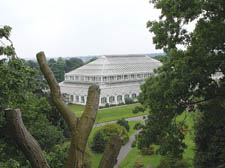|
|
 |
| |

Walkers enjoy a unique view of Kew Gardens |
Camden features | Peter Gruner| Trip to Kew Gardens | Tree walkway | Royal Botanical Gardens
CAMPAIGNERS in Camden and Islington fighting to save their precious green heritage can re-charge their energies by taking a trip to Kew Gardens’ magnificent new towering tree walkway.
The Royal Botanical Gardens are easy to get to by going on the London Overland train, which travels through a part of the capital that hasn’t changed since the 1950s.
With one train and no changes, the gardens are just five minutes away from Kew Gardens station. You can actually be walking above the tree tops just 40 minutes after departing from Highbury and Islington or Camden Road stations.
With pressure from councils and insurers to remove distinctive street and garden trees, residents would do well to arm themselves with facts. The new tree walkway, which opened last month, allows visitors to climb 18 metres (59 feet) into the usually inaccessible treetop world of Kew’s arboretum.
This 200-metre long permanent structure – designed by Marks Barfield, the architects of the London Eye – is not just a fascinating experience but also offers a great opportunity to learn a little about how trees work and the rich biodiversity of the forest canopy.
Treetops are home to a vast collection of plants and animals and act as the planet’s lungs, yet we know surprisingly little about them.
Visitors are provided with information about how trees play host to hundreds of species of animals and insects and how their leaves are vital in the fight against climate change.
Once in the canopy of the 50 mature broad-leaved trees making up the woodland, including sweet chestnuts, limes and deciduous oaks, visitors can spot birds such as tawny owls and woodpeckers, as well as mosses and lichens, insects and bats at dusk.
The tallest tree in this woodland – planted in the 18th century by Lancelot “Capability” Brown – is a 25-metre high sweet chestnut (Castanea sativa).
Intrepid tree walkers first pass through an underground exhibit on tree roots and life underground – the Rhizotron – before climbing spiral stairs six-storeys high (118 steps) to the top of the Xstrata Treetop Walkway platform.
There is a lift for the elderly and disabled, but we were told on Sunday that it won’t be available for another month.
Supported by the Hanson Environment Fund, the Rhizotron – the name is taken from the Greek rhiza, meaning root – uses animatronics and animations to show the development of roots and fungus.
It also explains how roots and soil work as the “engine room” of the forest and reveals the hidden world of “creepy crawlies” and fungi that thrive underground and on the forest floor.
Tony Kirkham, head of Kew’s arboretum and project manager for the Rhizotron and Xstrata Treetop Walkway project, said: “We want to tell the story of a tree’s role in diversity in this planet and as a key contributor in capturing carbon to help in the fight against climate change.
“Rates of forest clearing are appallingly high around the world and Kew scientists see the effects of deforestation first-hand on their travels.
“We are losing trees and forests at an alarming rate. Fewer trees mean more endangered species and poorer quality air.”
•
|

|
 |
|
 |
|

